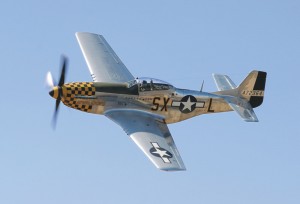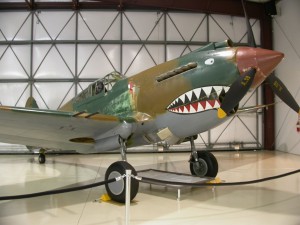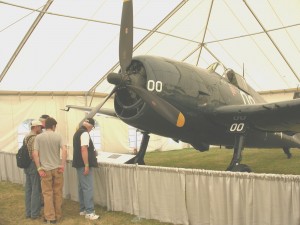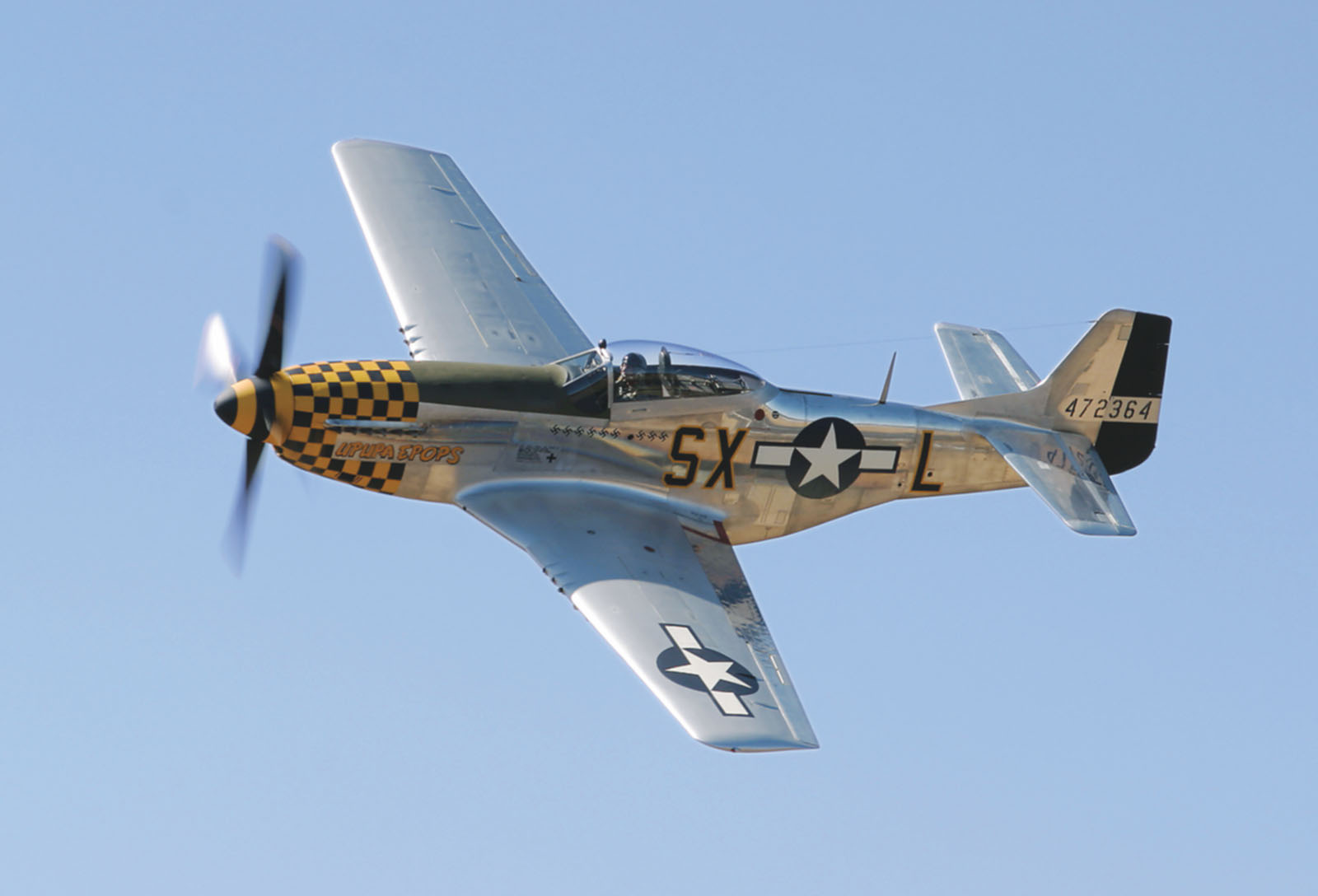By Terry Stephens

A North American P-51, Upupa Epops, shown flying over Arlington Municipal Airport, is part of Paul Allen’s Flying Heritage Collection. The collection has been at the city airfield since 2004, but will move to larger quarters at Paine Field in 2007.
Snohomish County Airport/Paine Field (PAE), home to the Future of Flight Center and Boeing Tour facility, will soon have another major aviation tourism attraction—Paul Allen’s Flying Heritage Collection of rare World War II and Cold War military aircraft.
The billionaire Microsoft cofounder’s collection of rare, restored American, British, German and Russian warbirds, now based at Arlington Municipal Airport (AWO), 25 miles northeast of Paine Field, will be moved to the much larger airfield before the end of 2007.
Dave Waggoner, director of Paine Field, welcomed the news, saying Paul Allen’s Vulcan Investment Company had searched airfields along the West Coast before deciding on Paine Field.
“We’re excited about having this new tenant,” Waggoner said. “They obviously bring a wonderful new attraction to the airport and we’re delighted that they chose to stay in Snohomish County. I think it will draw local, national and even international visitors, and that’s good for Snohomish County tourism.”
Jason Hunke, a spokesman for Vulcan Investment Co., said the move to Paine Field will greatly expand the display space for the aircraft and make the collection much more accessible to the public, since it’s a larger urban setting. Three dozen or more planes will be displayed at the new site, compared to around a dozen at Arlington.
Hunke said Vulcan likes the idea that Paine Field is home base for the Boeing Co.’s 747, 767, 777 and 787 airliner assembly plant; the newly opened Future of Flight Center and Boeing Tour facility; and the Seattle Museum of Flight’s aircraft renovation center. All are open to the public.
“We always knew that as the collection grew, and as we focused more on what the visitor experience would be, a possible change of location would be in the mix,” Hunke said. “We knew Arlington would be one of the potential locations, but the Everett location was the right one.”
Rob Putnam, Arlington Airport manager, said he hates to see the museum moved, and was hoping they would decide to remain permanently.

The Flying Heritage Collection includes this Curtiss P-40C Warhawk, once flown in combat with the Flying Tigers over China.
“I think once they get the facility up and running, it’s going to be a regional draw for tourism,” he said.
Snohomish County Councilman John Koster, an Arlington resident, said he’s sad to see the Flying Heritage Collection move, but called it a fabulous collection that he hopes people will take the opportunity to see.
Since 2004, a dozen of the Flying Heritage Collection’s planes have been displayed in green metal hangars on the west side of the Arlington airfield, about two miles from Interstate 5. Due to the limited space and mostly volunteer docents and tour guides, the museum has had little publicity and no daily hours for visitors. Instead, reservations were taken for Fridays and Saturdays only, at $20 per person. According to Vulcan records, the airport’s low profile has attracted annually only about 3,000 visitors a year. Those who have visited the facility have been treated to guided tours, led by docents who provide details about the history and war record of each aircraft on display.
The Flying Heritage Collection displayed museum aircraft at the 2005 and 2006 Arlington Northwest EAA Fly-Ins on the east side of the airfield. Shuttle buses took air show visitors to free tours at the FHC museum on the airfield’s west side.
The size of the collection will continue to expand as more and more planes in the inventory are restored to flying condition and display status, making a larger facility essential. This year, Allen added his Republic P-47D Thunderbolt and Messerschmitt Bf 109 to the display at Arlington. Within months, they will be joined by a restored Hawker Hurricane Mk. X11B.
Hunke said Allen wants more exposure for his historic planes, which include a North American P-51 Mustang and B-25J Mitchell, Curtiss P-40C Warhawk and JN-4D Jenny, Grumman F6F-5 Hellcat, Hawker Hurricane Mk. X11B, Polikarpov U-2/PO-2 and I-16 Type 24, Fiesler Fi-156-C2 Storch and a Vickers-Supermarine Mk. Vc Spitfire. The collection also includes a Focke-Wulf FW 190A-5, Goodyear FG-1D Corsair, Boeing B-17E Flying Fortress, Messerschmitt Me-262A-1a Schwalbe, Ilyushin IL-2M-3 Sturmovik and a Lockheed P-38 Lightning.
Future restoration projects include a Heinkel He 111H, Nakajima Ki-43-1b Hayabusa, North American F-86A Sabre, Mitsubishi A6M5-52 Zero-Sen, Yakovlev Yak-3U, Republic F-105G Thunderchief, a Vought F-8 Crusader, Mikoyan-Gurevich MiG-21, Hawker-Siddeley Harrier GR.3, de Havilland DH98 Mosquito and a Messerschmitt Me 163B Komet.
Each of the planes have been flown in combat, except for a rare bi-winged Curtiss Jenny, built in 1918 to train combat pilots in World War I. Detailed histories of each plane have been pieced together during the reconstruction process.

This Grumman F6F-5 Hellcat, which was on display at the 2005 Northwest EAA Arlington Fly-In in 2005, is one of the aircraft in the Flying Heritage Collection that will move to Paine Field.
Allen bought at least one plane from a museum. The German Me-262, the world’s first jet fighter plane, came from the Planes of Fame collection in Chino, Calif. Others were found in various parts of the world, some buried in yesteryear’s battlefields, others resting and rusting at old airfields.
The Allen collection is unusual, not only because the planes are being restored to flying condition, but also because of his commitment to recreating each one so meticulously.
Only original parts are used, except in rare occasions where pieces can’t be found, and authenticity is taken to extreme lengths. Cotton-coated wiring and lacquer and enamel paints are used. Vintage cockpit furnishings have been pieced together from a variety of sources, including original radios that still operate.
Allen’s restored aircraft are usually flown four times a year, to keep the engines and other moving parts in prime shape.
Allen began quietly buying remnants of old war planes in 1998, but didn’t publicly acknowledge the existence of his collection until 2004, when the first restored planes were displayed at the Arlington site.
In preparation for stepping up publicity about the Flying Heritage Collection and making it a world-class attraction in its new quarters at Paine Field, the senior director of Vulcan’s Flight Management Division is searching for a new executive director for the collection. Applicants need experience in museum management, public relations and marketing. Previous experience in historic aircraft museum management would be an advantage.
For more information, or tours of the Flying Heritage Collection at Arlington, call 360-435-2172 or visit [http://www.flyingheritage.com].











